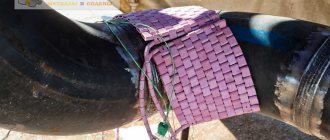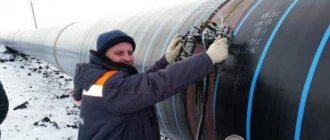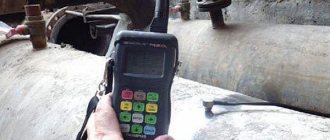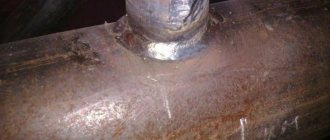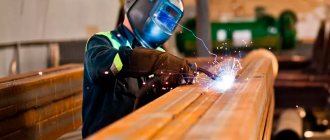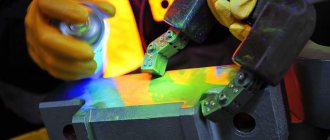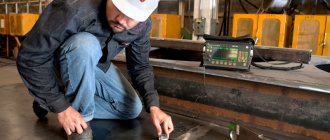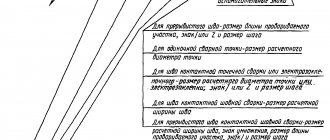A new line of induction heaters (6th generation) has been launched. The entire SWP model range has been updated:
- - medium-frequency induction heaters (MF) with an operating frequency of 6-10 kHz;
- — high-frequency induction heaters (HF) with an operating frequency of 15-30, 30-60 or 50-120 kHz.
Medium-frequency induction heaters are designed for metal melting and forge heating of workpieces starting from a diameter of 50 mm. Low frequency allows you to heat the workpiece evenly throughout the entire volume.
High-frequency induction heaters allow you to perform induction soldering, induction (forging) through heating of workpieces and hardening of parts to a depth of 3-5 mm (if a special hardening transformer is available). HF installations are most often used in scanning hardening and make it possible to achieve a hardening layer 1-2 mm thick. Also, high-frequency induction units can be used for soldering or desoldering of carbide alloys.
The SWP line of induction heaters has switched to new modern four-layer control boards. HDTV installations are known for their sensitivity to operating conditions and require certain operating experience. The new board eliminates errors that may be made when working with the installation. It monitors all operating parameters, including input voltage/current, coolant temperature and inductor short circuit, allowing the unit to be shut down in time without burning out the internal electronics. New IGBT modules of the KT series are also used.
All installations have a touch screen. This innovation expands the capabilities of the induction installation and allows for external control (4-20 mA, 0-10 V, 0-5 V, RS485), connecting external pyrometers and thermocouples. The touch screen also allows you to program the unit to operate in different modes. The new design of the case has an air machine and an emergency shutdown button for the unit. Additional forced air cooling of the case was added.
Updated induction heaters are already available for order.
- High Frequency Induction Heaters (HF Series)
- Medium frequency induction heaters (SS Series)
INDUCTION HEATER is an electric heater that operates by changing the flux of magnetic induction in a closed conductive circuit. This phenomenon is called electromagnetic induction. Want to know how an induction heater works? ZAVODRR is a trade information portal where you will find information about heaters.
Vortex induction heaters
An induction coil is capable of heating any metal, heaters are assembled using transistors and have a high efficiency of more than 95%; they have long replaced lamp induction heaters, whose efficiency did not exceed 60%.
A vortex induction heater for non-contact heating has no losses in adjusting the resonant coincidence of the operating parameters of the installation with the parameters of the output oscillatory circuit. Vortex-type heaters assembled on transistors are able to perfectly analyze and adjust the output frequency in automatic mode.
Elements and coil:
The working coil has 5 turns; a copper tube with a diameter of about 1 cm was used for winding, but less is possible. This diameter was chosen for a reason; water is supplied through the tube to cool the coil and transistors.
I installed IRFP150 transistors since IRFP250 was not nearby. Film capacitors are 0.27 µF 160 volts, but you can set 0.33 µF and higher if the first ones cannot be found. It is necessary to pay attention that the circuit can be powered with a voltage of up to 60 volts, but in this case, it is recommended to install capacitors at a voltage of 250 volts. If the circuit is powered by a voltage of up to 30 volts, then 150 is absolutely enough!
It is allowed to install any zener diodes at 12-15 volts from 1 Watt, for example 1N5349 and the same. Diodes can be used UF4007 and the same ones. Resistors 470 Ohm from 2 Watts.
Metal induction heaters
Heaters for induction heating of metal have a non-contact method due to the action of a vortex field. Different types of heaters penetrate the metal to a certain depth from 0.1 to 10 cm, depending on the selected frequency:
- high frequency;
- average frequency;
- ultra high frequency.
Induction metal heaters make it possible to process parts not only in open areas, but also to place heated objects in isolated chambers in which any environment, as well as a vacuum, can be created.
How to make an induction heating boiler for your home with your own hands
The technologies by which the induction boiler is designed and operates help reduce electricity costs. You can do it yourself.
To do this, you should first study the principle of operation and prepare the necessary materials for assembling the unit. There are different types of homemade induction heaters.
Masters in car repair shops use the properties of the induction phenomenon to repair cars. But for heating water it is much better to purchase a dragee boiler.
How does an induction boiler work?
The operating principle of a boiler with an induction coil is based on the conversion of electrical energy into thermal energy.
The inductor is located in a sealed metal casing - a core, which heats up under the influence of Foucault currents. Magnetic strength and induced eddy currents are amplified by converting the 50 Hz mains current to high frequency before it enters the primary winding of the induction coil. This allows you to increase the heating temperature.
The heat exchanger is a labyrinth with thickened walls. This shape allows for better heating of the coolant due to an increase in the heat transfer area. The housing and secondary winding in vortex heaters are made of ferromagnets to accelerate heating of the coolant. Additional reactive power is generated by the coil because the conductor is placed in an alternating field.
Water enters the boiler, where it warms up to the set temperature upon contact with the core, and disperses through the pipes and radiators of the heating system.
With rapid heating, convection currents appear in the water. Expanding when warmed up, the coolant tends upward, creating a pressure difference.
For a small circuit this is enough; if you need the liquid to move faster, install a circulation pump.
Advantages and disadvantages of induction heating boilers
Creating an induction heating system reduces energy consumption costs. Induction boilers have many positive aspects, thanks to which they are increasingly being installed in houses without gasification. True, such units are not cheap.
Advantages of using electric induction boilers
Like all new technologies, this equipment has many advantages:
- Using automation, the desired temperature of the liquid in the heating system is set. Temperature sensors and relays maintain the set numbers, this makes induction heating boilers autonomous and safe.
- Induction boilers can heat any liquid - water, ethylene glycol, oil and others.
- The efficiency of all electric boilers with induction exceeds 90%.
- The simple design makes these devices very reliable. They can last up to 30 years if used properly.
- Due to their small size, it is not necessary to make a separate room; the units can be easily installed in any part of the building and independently introduced into the heating system.
- Due to the constant vibration of the core and the closed system, scale does not form on the heater.
- The induction boiler is economical. It turns on only if the coolant temperature has dropped. Automation brings it to the specified numbers and turns off the device. All this happens very quickly. Working “idle”, it consumes little energy due to the low inertia of the system.
Negatives and weaknesses
There are also disadvantages:
- High prices for these relatively new devices. The lion's share of the cost is in the automation, but the better it works, the more energy is saved.
- A power outage results in the heating in the house being turned off. A solution to the problem is a diesel or gasoline generator.
- Some models produce a strong background noise during operation. These are placed in technical storage rooms.
- If a system breakthrough occurs and the water does not cool the core, it will melt the body and mounting of the boiler. If this happens, the shutdown is carried out automatically.
Basic rules for the safe organization of induction heating
Different requirements for the operation of induction boilers and conventional units are due to their differences.
- The boiler must be connected via a dedicated cable connected directly to the electrical panel. No other devices should be connected to this line.
- When installing an electric boiler with induction, you need to secure the electrical networks in the house and eliminate the risk of fire in the wiring. To do this, the cable characteristics must exceed the total power of all electrical appliances in the house by 20%.
- Induction boilers can only be installed in closed-loop heating systems. To improve fluid circulation, an additional pump is installed.
- If the coolant overheats, excess pressure will arise in the system. To compensate for this, an expansion tank is installed. The internal temperature in an induction boiler can reach a value of 110°C.
- To safely use an electric boiler with induction, it is necessary to install pressure and temperature sensors on it. If there is a danger of overheating of the coolant and subsequent violation of the sealed circuit of the heating system, the boiler control unit will turn off the heating device based on sensor readings.
- To ensure that the heating pipes do not sag or become deformed during use, the temperature of the coolant is set no higher than the permissible values, which must be pre-calculated before installing the system.
- The heating system in your home requires backup power. For this purpose, an emergency generator is installed.
Calculation of boiler power for different rooms
If you decide to make induction heating of a private house with your own hands, then in order for all rooms to be warm, you need to calculate the power of the boiler. The same applies to production premises.
The power of induction boilers varies from 2 to 1500 kW. Area 10 sq. m. can heat 1 kW of power. For a home or office building, it can be calculated based on the area of the room. Workshops, warehouses and other premises must be calculated by volume.
When calculating, the heat loss of the building is also taken into account; a well-insulated house will not require the installation of a high-power boiler, but an industrial building without proper thermal insulation will require a powerful unit. Also note that the boiler should not constantly operate at maximum values.
Options for making homemade water heaters
If desired, you can assemble an induction heater at home yourself. And if such a device cannot be called ideal for heating a house, then it is quite suitable for heating a garage or outbuildings.
Types of homemade crafts
The line of “handmade” designs of economical heat generators is constantly updated with new inventions by home craftsmen. The tested options include the following:
- induction boiler made of plastic pipe and welding inverter;
- induction cooker heater;
- boiler made of two pipes and a three-phase inverter.
Take as a basis the drawings of an induction boiler made by other craftsmen with your own hands. You need to think about not only the location of the components of the overall heating system, but also the direct design and electrical circuit. An example of such a scheme is in the photo.
Assembling a water heater from a plastic pipe
To make the body, prepare a plastic pipe with thick walls and an internal diameter of 5 cm. You will also need wire with a cross-section of 7 mm. Stock up on adapters to connect the inlet and outlet openings of the boiler with the heating pipe system. For power supply you need a welding inverter with a power of 15 A or more.
- Take a plastic pipe and fix a fine-mesh metal mesh at one end so that the heating elements made from pieces of wire do not fall through.
- Immediately weld the adapter for mounting the boiler to the heating system.
- Cut the wire into pieces 1 to 6 cm long.
- Place the resulting cuts into the pipe, avoiding free space.
- Secure the free end of the pipe with a metal mesh.
- Install a second fitting to connect to the heating system.
- Wind 80 to 90 turns of copper wire around the pipe, keeping the same distance between each circle of winding.
- Connect the ends of the winding of the improvised coil to the poles of the inverter of the welding machine.
- Insulate all electrical connections.
- Connect the heater to the heating of the house so that water flows into the improvised boiler from the bottom up.
- Install a pump to ensure coolant circulation in the system.
- Connect a thermostat to the inverter to automate the operation.
: DIY induction boiler core
Creating a heating device from an induction cooker
This option is a little more complicated; you will need to know how to use an angle grinder and welding. Before starting work, prepare a 50x50 square pipe made of metal 2 mm thick and an induction cooker.
To heat a large room, you will need a model with high power.
- Use a grinder to cut the profile pipe into 5-6 pieces of 50 cm each, determine their number based on the size of the tile.
- Make two lengths of 25 or 30 cm, depending on the number of tubes in step 1.
- Place the long parts vertically and weld them together, thoroughly welding all joints.
- Make short blanks in a U-shape by cutting off one edge.
- Make a general outline by welding cut profiles to the previously welded structure of 5 tubes.
- Weld all existing holes to create a sealed product.
- Insert 2 fittings through which the coolant will enter and exit, placing them diagonally at the top and bottom. Additionally, weld threaded elbows to the pipe for further installation in the heating system.
- Finish the seams with a grinder, sand and paint the finished body.
- Place the device in the heating system in a previously prepared place.
- Place the stove against the back wall of the boiler and turn it on.
Such a system will require the mandatory installation of an expansion tank and a pump for constant coolant movement.
: Making a boiler from a stove
Homemade boiler made from two metal pipes and an inverter
Prepare two pipes 500 mm long, the diameter of the first should be 160 mm, the second – 25 mm. You will also need copper wire, epoxy resin, fireproof fabric and a current converter.
- Plug a piece of pipe with a smaller diameter. You can cut a circle, wrap it inside and boil it, or put on a tip.
- Make spacer ribs in a large pipe and weld the structure made in the previous step to them.
- Weld the plugs with the input and output fittings pre-inserted into them onto the large sleeve.
- Sand, clean and degrease the resulting system.
- Dilute the epoxy resin and saturate the fireproof fabric with it.
- Wrap the pipe in fabric and let it dry completely.
- Wrap 54 turns of copper wire at equal distances around the top and bottom of the boiler and coat the entire conductor with epoxy.
- Wrap the case with heat-resistant tape.
- In parallel, connect the resulting coils to the high-frequency converter.
- Be sure to make a protective casing to prevent the conductors from being damaged.
- Install the product in the heating circuit.
Similar to the situation with other homemade boilers, you will need to install a pump.
Homemade induction heater in a car service
Induction appliances are used not only for heating homes. They will be good helpers in heating metals in a car service center. In order not to spend money on an expensive unit, you can make an induction heater for a car service yourself.
Using such a heater, you can remove any glue and glued parts from the car and remove the anti-gravel protection.
Heating the bolts and nuts makes it easy to unscrew them, despite the fact that the hardware has soured. The inverter heater also helps remove small dents on the car body without damaging the paint.
: Assembly of an induction heater for a car service
Modern electric boilers with induction do an excellent job of maintaining heat in the room. Do-it-yourself induction heating will save a decent amount of money. The main condition for long and trouble-free operation of home-made units is compliance with the requirements for their correct operation and safe installation.
Electric Induction Heater
High frequency electric induction heater is gaining new applications every day. The heater operates on alternating electric current. Most often, induction electric heaters are used to bring metals to the required temperatures during the following operations: forging, soldering, welding, bending, hardening, etc. Electric induction heaters operate at a high frequency of 30-100 kHz and are used to heat various types of media and coolants.
Electric heater is used in many areas:
- metallurgical (HDTV heaters, induction furnaces);
- instrument making (soldering of elements);
- medical (production and disinfection of instruments);
- jewelry (jewelry manufacturing);
- housing and communal services (induction heating boilers);
- food (induction steam boilers).
What you need to know about security
Do not forget that we are dealing with a source of increased danger - an electric heating device, therefore, when assembling and using it, you must follow some rules:
Be sure to use a separate electrical line to connect the induction boiler, and also equip it with a safety group.
- If water circulates naturally in the boiler, be sure to equip it with a temperature sensor so that if it overheats, the device turns off automatically.
- Do not connect a homemade water heater to an outlet; it is better to draw a separate line for this with a larger cable cross-section.
- All exposed sections of wires must be insulated to protect people from electric shock or burns.
- Never turn on the inductor if the pipe is not filled with water. Otherwise, the pipe will melt and the device will short out or it may even catch fire.
- The device must be mounted at a height of 80 cm from the floor, but so that about 30 cm remains from the ceiling. Also, you should not install it in a residential area, since the electromagnetic field has a bad effect on people’s health.
- Don't forget to ground the inductor.
- Be sure to connect the device through an automatic circuit breaker so that in the event of an accident, the latter will cut off the power from the water heater.
- A safety valve must be installed in the pipeline system, which will automatically reduce the pressure in the system.
Medium Frequency Induction Heaters
When deeper heating is required, medium-frequency type induction heaters are used, operating at medium frequencies from 1 to 20 kHz. Compact inductors for all types of heaters come in a variety of shapes, which are selected so as to ensure uniform heating of samples of the most varied shapes, while it is also possible to carry out specified local heating. The mid-frequency type will process materials for forging and hardening, as well as through heating for stamping.
Easy to operate, with efficiency up to 100%, induction mid-frequency heaters are used for a wide range of technologies in metallurgy (also for melting various metals), mechanical engineering, instrument making and other fields.
- Induction heater 15 kW Moscow
- Induction heater 60 kW Perm
- Induction heater 80 kW Ekaterinburg
- Induction heaters 120 kW Ekaterinburg
Application:
- mechanical engineering industry
- metalworking industry
- melting of ferrous and non-ferrous metals
- deep heating of workpieces
- hot stamping
- hardening of metals to maximum depth
- hardening of crane wheels.
more details
Selecting a cable and machine
When renovating new apartments, the boiler is usually wired separately directly from the panel.
If you want to connect the boiler to the old common wiring, which already has several sockets connected, be sure to make sure that it can withstand the power of the boiler. In most cases, with a power of up to 3.5 kW, wiring must be done with a 3-core copper cable VVGnG-Ls, with a cross-section of at least 2.5 mm2.
The three-core cable is required to ensure a permanent connection to ground.
Choose a two-pole boiler connection machine. The rated current of the machine is 16A (sufficient for boiler power up to 3.5 kW).
For loads up to 2 kW, a circuit breaker with a rated current of 10 A is suitable.
High Frequency Induction Heaters
The widest range of applications is for high-frequency induction heaters. The heaters are characterized by a high frequency of 30-100 kHz and a wide power range of 15-160 kW. The high-frequency type provides shallow heating, but this is enough to improve the chemical properties of the metal.
High-frequency induction heaters are easy to operate and economical, and their efficiency can reach 95%. All types operate continuously for a long time, and the two-block version (when the high-frequency transformer is placed in a separate block) allows round-the-clock operation. The heater has 28 types of protection, each of which is responsible for its own function. Example: monitoring water pressure in a cooling system.
- Induction heater 60 kW Perm
- Induction heater 65 kW Novosibirsk
- Induction heater 60 kW Krasnoyarsk
- Induction heater 60 kW Kaluga
- Induction heater 100 kW Novosibirsk
- Induction heater 120 kW Ekaterinburg
- Induction heater 160 kW Samara
Application:
- surface hardening of gear
- hardening of shafts
- hardening of crane wheels
- heating parts before bending
- soldering of cutters, milling cutters, drill bits
- heating the workpiece during hot stamping
- landing bolts
- welding and surfacing of metals
- restoration of parts.
more details
Large storage systems
We found out what the main disadvantage of the “pipe-in-pipe” water heating element is. Indirect heating takes too long. Since increasing heat transfer is difficult, you can use a larger container to heat water. Then you can “conjure” the heat exchanger. The best option in the illustration: a coil inside a wide body.
The design is a tank of the required capacity (50, 100, 200 liters), inside of which there is a coil (the longer, the more effective the heating). The heat source does not matter: usually it is the room heating circuit. The water in the sanitary (internal) tank warms up quite quickly. The only problem is the uneven distribution of heat. A “cold” area remains at the bottom of the container. Despite the correct selection of heated water (receiving pipe from above), the cold area does not allow the entire volume to warm up.
When making it yourself, it is recommended to use a stainless steel tank and a copper coil. The additional costs will be offset by the high efficiency of the system.
Moreover, materials are not in short supply. The tank will fit from an old activator-type washing machine. A copper tube is sold at any plumbing store.
Another option: “tank in tank”. If you are faced with the question of how to make a boiler with your own hands, take a closer look at this diagram.
The internal container (in which indirect heating will occur) is selected with corrugated walls (preferably). This means there is a larger heat exchange area. And the primary heating water flows through an external point. If you cooled a pan of hot compote in a bowl of cold water, the principle of operation of the heater is clear.
Of course, such a system is more difficult to implement, but the efficiency will be higher.
Ultra High Frequency Induction Heaters
Microwave induction heaters operate at superfrequencies (100-1.5 MHz) and penetrate to a heating depth (up to 1 mm). The ultra-high-frequency type is indispensable for processing thin, small, small-diameter parts. The use of such heaters allows one to avoid unwanted deformations associated with heating.
Ultra-high-frequency induction heaters based on JGBT modules and MOSFET transistors have power limits of 3.5-500 kW. They are used in electronics, in the production of high-precision instruments, watches, jewelry, for the production of wire and for other purposes requiring special precision and filigree.
Application:
- electronics industry
- wire production
- annealing of wire raw materials
- soldering carbide teeth
- welding of frames for glass glasses welding of jewelry and watches in the electronics industry
- heating very thin wires
- heating small electronic equipment
- tool production hardening
- release of thin metal parts.
more details
Forge induction heaters
The main purpose of forging-type induction heaters (IH) is heating of parts or parts thereof, prior to subsequent forging. Blanks can be of different types, alloys and shapes. Induction forging heaters allow you to process cylindrical workpieces of any diameter in automatic mode:
- economical, as they only take a few seconds to heat up and have a high efficiency of up to 95%;
- easy to use, allow for: full process control, semi-automatic loading and unloading. There are options with full automation;
- are reliable and can work continuously for a long time.
- Induction forge heater 300 kW Moscow
- Induction forge heater 100 kW Ekaterinburg
- Induction forge heater 60 kW Amur
Application:
- heating of metal blanks
- heating of round billets
- hot stamping, bending, forging and upsetting
- heating of magnetic and non-magnetic metal workpieces, both non-ferrous metals (copper, aluminum) and ferrous metals (stainless and alloy steel), as well as cast iron.
more details
Induction shaft heaters
Induction heaters for hardening shafts work in conjunction with a hardening complex. The workpiece is in a vertical position and rotates inside a stationary inductor. The heater allows the use of all types of shafts for consistent local heating; the hardening depth can be fractions of millimeters in depth.
As a result of induction heating of the shaft along its entire length with instant cooling, its strength and durability increases many times over.
Application:
- hardening of shafts, axles and pins;
- hardening of gears, gears and rims;
- HFC hardening of teeth or cavities
- cracks and internal parts of parts
- crane wheels and pulleys
Most often, high-frequency hardening is used for parts that consist of carbon steel.
more details
Induction pipe heaters
All types of pipes can be treated with induction heaters. The heater for pipes can be air- or water-cooled, with a power of 10-250 kW, with the following parameters:
- Induction heating of an air-cooled pipe is carried out using a flexible inductor and a thermal blanket. Heating temperature up to 400 °C, and use pipes with a diameter of 20 - 1250 mm with any wall thickness.
- Water-cooled pipe induction heating has a heating temperature of 1600 °C and is used to “bend” pipes with a diameter of 20 - 1250 mm.
Each heat treatment option is used to improve the quality of any steel pipe.
Application:
- preheating of pipes before welding;
- heat treatment of pipeline welds;
- heat treatment of metal containers
- heating of petroleum products
more details
Delivery contents
Package Included:
1 frequency converter
2 induction heater
3set of cables, conductors and hoses for interblock connections in accordance with the mutually agreed layout of equipment placement in the workshop
4 single set of spare parts
5set of replaceable feed-through inductors for the required range of pipes or rods – 1 set
6commissioning
Optional equipment:
spare parts repair kit,
remote heating control panel.
Induction pipe heating units
| installation type | Medium frequency power, kW | Operating frequency, kHz | Productivity when heating pipes at 200°C, kg/hour | Cooling water flow at 20°C | Weight, kg |
| INT-30-10.0 | 30 | 8,0 (10,0) | 840 | 1, 0 | 140 |
| INT-30-44.0 | 30 | 44 | 840 | 2 | 150 |
| INT-63-10.0 | 63 | 10 | 1800 | 2,2 | 150 |
| INT-100-2.4 | 100 | 2,4 | 2800 | 2,2 | 180 |
| INT-160-2.4 | 160 | 2,4 | 4500 | 4,2 | 600 |
| INT-250-2.4 | 250 | 2,4 | 6300 | 4,3 | 1300 |
| INT-320-1.0 | 320 | 1 | 7700 | 6 | 1400 |
| INT-320-2.4 | 320 | 2,4 | 7700 | 6 | 1400 |
| INT-400-2.4 | 400 | 2,4 | 9500 | 6 | 1400 |
| INT-630-2.4 | 630 | 2,4 | 15000 | 11 | 1820 |
| INT-800-2.4 | 800 | 2,4 | 19000 | 14 | 2000 |
Pyrometer for heating control
One of the most important operating parameters of induction heaters is temperature. For more careful monitoring of it, in addition to built-in sensors, infrared pyrometers are often used. These optical devices allow you to quickly and easily determine the temperature of hard-to-reach (due to high heat, the possibility of exposure to electricity, etc.) surfaces.
If you connect a pyrometer to an induction heater, you can not only monitor the temperature, but also automatically maintain the heating temperature for a specified time.
Application:
- induction heaters;
- melting furnaces;
- temperature control;
- heating in a given period of time
more details
Control unit and control panel
The Petra frequency converter automatically maintains the specified pipe heating mode, thereby ensuring stabilization of the inductor current.
The load condition is controlled by the frequency converter, maintaining the operation of the inverter in the range of safe modes from open to short circuit.
The protection system serves for emergency shutdown, limiting overvoltages and ensures contactless shutdown of the frequency converter.
The control unit monitors the temperature of power transistors.
The control system allows you to regulate and stabilize the output power in the range of 5–100% of different load quality factors and provides communication with external equipment via the RS-485 bus.
Indication of the converter modes informs about the operation of this device, as well as the state of the interlocking and protection system.
The front panel of the converter contains the “Start”, “Stop” buttons and a power control knob.
The temperature of the pipe at the outlet of the inductor is monitored in a non-contact manner using a pyrometer. To control the technical process, the remote control is based on a PLC and an HMI panel. The use of an intelligent control panel provides visualization of the technical process and the creation of technological reporting documentation (logging).
Operating principle of induction heaters
During operation, a magnetic field is formed in the inductor, into which the part is placed. Depending on the task (depth of heating) and the part (composition), the frequency is selected; it can be from 0.5 to 700 kHz.
The principle of operation of the heater according to the laws of physics states: when a conductor is in an alternating electromagnetic field, an EMF (electromotive force) is formed in it. The amplitude graph shows that it moves proportionally to the change in the speed of the magnetic flux. Due to this, eddy currents are formed in the circuit, the magnitude of which depends on the resistance (material) of the conductor. According to the Joule-Lenz law, current leads to heating of a conductor that has resistance.
The operating principle of all types of induction heaters is similar to a transformer. The conductive workpiece, which is located in the inductor, is similar to a transformer (without a magnetic core). The primary winding is an inductor, the secondary inductance of the part, and the load is the metal resistance. During high-frequency heating, a “skin effect” is formed; eddy currents that form inside the workpiece displace the main current onto the surface of the conductor, because the heating of the metal on the surface is stronger than inside.
What is an induction water heater and how does it work?
The operating principle of all induction-type devices is based on the ability of eddy (induced) currents to heat objects located in the radiation field. An induction instantaneous water heater still belongs to the category of equipment that is constantly being improved, but existing models also have a fairly high thermal power.
Structurally, a water heater of this type is a closed metal container of small diameter. The main element is a high-frequency induction coil placed inside the tank. The characteristics of the wound spiral depend on the required power and performance of the device. Inside the coil there is a small diameter pipeline through which heated water passes.
The main electrical element is a step-down transformer and an inverter, which makes it possible to obtain high-frequency currents from ordinary household electricity. When such a current passes through the induction coil, the space inside it is heated, which can be filled with special antifreeze or even ordinary water.
Due to the increase in temperature inside the coil, the water passing through the copper tube is heated. Copper is used due to its good thermal conductivity.
Operating principle of an induction water heater
As you can see, the circuit of an induction water heater is quite simple. Having the skills to work with electrical equipment, you can even assemble such a device yourself.
Experts note a number of positive aspects of using induction technology to provide hot water supply and even heating:
- Induction-type units are characterized by exceptional durability. The average service life reaches 25-30 years. This does not require expensive maintenance; preventative cleaning can be carried out once every 10 years.
- Induction water heaters can have significant thermal power, along with this, electricity consumption (compared to traditional equipment using heating elements) is reduced by 30-50%.
- The formation of scale on an induction heating element is impossible in principle. An alternating magnetic field prevents the formation and deposition of sparingly soluble salts on the internal surfaces of the structure.
Of course, water heaters of this type cannot be classified as cheap household appliances; today, even modifications of small power cost at least 30 thousand rubles. But constant improvements in design and increased sales volumes lead to a gradual reduction in prices for such devices. Therefore, in the near future, induction water heaters may become available to the general public.
Advantages of induction heaters
An induction heater has undoubted advantages and is a leader among all types of devices. This advantage is as follows:
- It consumes less electricity and does not pollute the surrounding space.
- Easy to use, it provides high quality work and allows you to control the process.
- Heating through the walls of the chamber ensures special purity and the ability to obtain ultra-pure alloys, while melting can be carried out in different atmospheres, including inert gases and vacuum.
- With its help, it is possible to uniformly heat parts of any shape or selective heating
- Finally, induction heaters are universal, which allows them to be used everywhere, displacing outdated energy-consuming and inefficient installations.
Pros and cons of induction water heating devices
The device has a fairly simple design and does not require special documents permitting use and installation. The induction water heater has a high degree of efficiency and optimal reliability for the user. When using it as a heating boiler, you don’t even have to install a pump, since water flows through the pipes due to convection (when heated, the liquid practically turns into steam).
The device also has a number of advantages, which sets it apart from other types of water heaters. So, an induction heater:
In induction heaters, water becomes hot due to the pipe through which it flows, and the latter is heated due to the induction current created by the coil.
- much cheaper than its analogues, such a device can be assembled independently without any problems;
- completely silent (although the coil vibrates during operation, this vibration is not noticeable to humans);
- during operation it vibrates, thanks to which dirt and scale do not stick to its walls, and therefore does not require cleaning;
- has a heat generator that can be easily made sealed due to the operating principle: the coolant is located inside the heating element and the energy is transferred to the heater via an electromagnetic field, no contacts are needed; therefore, there will be no need for rubber seals, seals and other elements that can quickly deteriorate or leak;
- there is simply nothing to break in the heat generator, since the water is heated by an ordinary pipe, which is unable to deteriorate or burn out, unlike a heating element;
Don’t forget that servicing an induction heater will be much cheaper than a boiler or gas boiler. The device has a minimum of parts that almost never fail.
Despite the huge number of advantages, an induction water heater also has a number of disadvantages:
- the first and most painful for owners is the electricity bill; the device cannot be called economical, so you will have to shell out a fair amount of money to use it;
- second, the device gets very hot and heats not only itself, but also the surrounding space, so it is better not to touch the body of the heat generator during its operation;
- third, the device has extremely high efficiency and heat transfer, so when using it, be sure to install a temperature sensor, otherwise the system may explode.
Repair of induction heaters
Repair of induction heaters is carried out using spare parts from our warehouse. At the moment we can repair all types of heaters. Induction heaters are quite reliable if you strictly follow the operating instructions and do not allow excessive operating conditions - first of all, monitor the temperature and proper water cooling.
The subtleties of operation of all types of induction heaters are often not fully published in the manufacturers' documentation; their repairs should be carried out by qualified specialists who are well acquainted with the detailed operating principle of such equipment.
